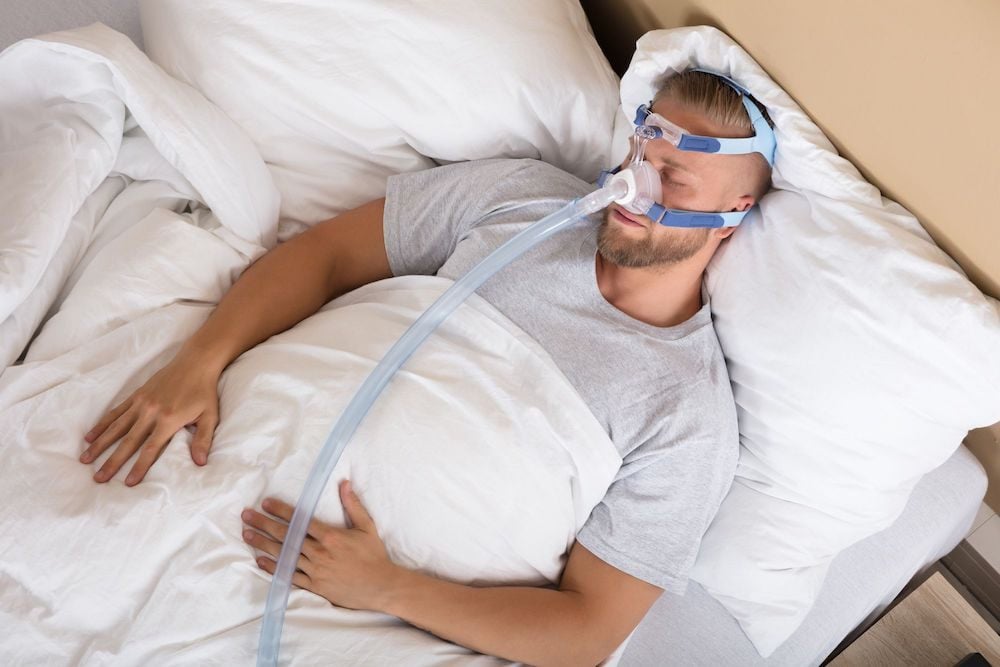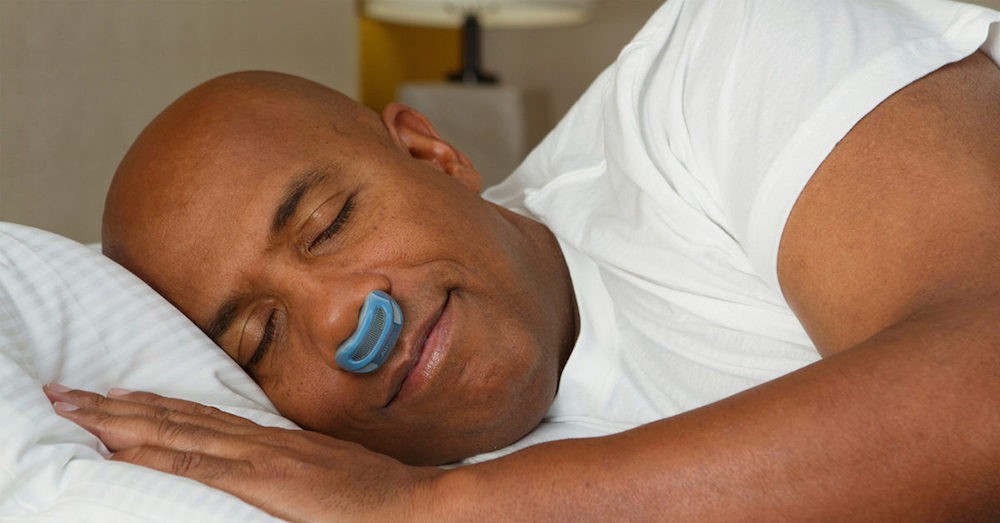Technology has come a long way, with new developments being discovered and studied worldwide almost every hour. Innovation brought by constant research is what helps address modern problems, even issues that have persisted for decades.
In my opinion, one aspect of human life that has greatly benefitted from technology is health and medicine. For example, sleep apnea sufferers who had to live with this disorder for a long time now have options to address and alleviate its symptoms.
Those who have this sleep disorder will be glad to know how technology can help with their condition. Learn more about the technology used to address sleep apnea.
- What Is Sleep Apnea
- Can Technology Help?
- Mouth Devices For Sleep Apnea
- Detection Devices While Sleeping
- Pillows Designed To Help With Sleep Apnea
- Nerve Stimulation Treatments

What Is Sleep Apnea?
Individuals suffering from sleep apnea know the worrying symptoms of this sleep disorder. Sufferers typically find themselves suffering from repeated breathing interruptions during sleep, causing them to snore and feel unrested even after sleeping at night.

I want to highlight that there are three types of sleep apnea, namely obstructive sleep apnea, central sleep apnea, and complex sleep apnea syndrome. The most common type is obstructive sleep apnea, which is caused by relaxed throat muscles obstructing airways, leading to breathing interruptions during sleep.
This sleep disorder is characterized by loud snoring, a stoppage of breathing during sleep, gasping for air, dry mouth upon waking up, headaches, insomnia, hypersomnia, lack of focus during wake times, and irritability. Keep in mind that symptoms for all types of sleep apnea often overlap.
To understand the second type, let me note that breathing while sleeping is an involuntary function controlled by the brain that sends signals to the relevant muscles. Central sleep apnea occurs when the brain fails to send the right alerts. The last type is a combination of these two.
Risk Factors For Sleep Apnea
There are different reasons why people develop this sleep disorder. Lifestyle definitely factors in. According to experts, individuals who consume alcohol, sedatives, tranquilizers, and cigarettes have an increased risk of developing this condition. Weight is also a risk factor.
However, there are elements that are out of patients’ control, including their age, sex because males have an increased risk, family history, nasal congestion, and medical conditions. Genetics also play a part as inherited thick necks, and narrow airways increase the risk.
I find the need to focus on the fact that sleep apnea is a chronic disorder, which means that it tends to persist for a long time and does not go away without considerable lifestyle changes or medical treatments. The good news is modern medicine has found a way to help address its symptoms.
Can Technology Help?
What I find remarkable about science and technology is that they have enabled the medical community to help address symptoms of sleep apnea. Throughout the years, researchers have developed devices and techniques to minimize the occurrence of breathing interruptions.

Some developments designed to address sleep apnea include airway pressure treatments, mouth devices, detection devices, and nerve stimulation treatments. So, to answer this question, technology can indeed help.
However, keep in mind that these are often used as therapies to help sufferers alleviate symptoms or avoid the manifestation of the disorder.
One of the most common treatments is Continuous Positive Airway Pressure (CPAP). This method is used for moderate to severe conditions that require you to wear a mask that delivers air pressure during sleep. This uses just the right amount of pressure to open up the airways.
How About Surgery?
Aside from the developments that allow patients to minimize sleep apnea symptoms, there is another option they can choose, but physicians do not initially recommend it. Patients can opt to undergo surgery to address the cause of their disorder more effectively.
Some of the surgical options include tissue removal, tissue shrinkage, jaw repositioning, implants, nerve stimulation, and creating a new air passageway or tracheostomy.
However, I need to emphasize that doctors will first recommend trying other treatment methods for a few months before opening up the possibility of surgery. For jaw structure issues, surgery could be the first option.
Mouth Devices For Sleep Apnea
Aside from CPAP, there are other ways to address sleep apnea through oral appliances. These are mouth devices placed on or in the mouth to enable the optimal passage of air through the airways. There are different ways that such devices help in treating sleep apnea.

Oral appliances aid sleep apnea patients by helping open up their throat by adjusting the lower jaw. A mandibular advancement device (MAD) does the job by attaching to the top and bottom teeth.
These look like athletic mouthguards with hinges that let the jaw go forward and stabilize the soft palate and tongue to prevent any obstruction to airways.
Another option I want to present is the tongue retaining device, which holds the tongue in place. This may be uncomfortable for many, but it works to prevent the tongue from hindering patients’ breathing while sleeping.
Choosing The Right Oral Appliance
While all of these mouth devices can help minimize the symptoms of this disorder, it would benefit patients to choose an appliance that perfectly addresses the reason for their sleep apnea.
I suggest you consult your doctor for an explanation of how each option is applied, as any discomfort can also negatively affect sleep.
Detection Devices While Sleeping
One factor that causes apnea and snoring in patients is their sleeping position. Detection devices are more comfortable options that seek to help them get into a position that will not trigger the disorder. For those who are like me who like to control their devices with an app, then this option is for you.

Each device is associated with a brand. An example of this is Hupnos Sleep Masks that cover the eyes and nose, which is a smart device that monitors the wearer’s sleeping position and listens for snores. In case of snoring, the mask vibrates enough to stir the wearer and releases air pressure to allow breathing.
The SmartSleep Snoring Relied Band has a similar principle. This is worn below the chest to aid patients in getting into the correct sleeping position. It has a sensor that vibrates when the wearer gets out of the ideal position.
Lastly, the GO2SLEEP Smart Ring is worn around a finger to monitor the wearer’s blood flow during different sleep stages. It also gathers data such as heart rates and body movements. Then, the device creates a personalized sleep coaching plan to help improve the patient’s sleep.
Choosing The Right Detection Device
All of these devices can be controlled using a smart application. To choose the right option, I find it essential to note what the patient prefers. For example, a sleep mask or a chest band can bring discomfort, but a ring may not.
Again, the best option is one that addresses the source of the apnea and snoring. So, if I snore due to my sleeping position, I need a device that can prompt me to get into an ideal position.
Pillows Designed To Help With Sleep Apnea
Pillows are an essential part of sleep. It can help individuals get into a comfortable yet ideal position for sufferers of apnea and snoring. Usually, these are designed to accommodate patients who use CPAP appliances.

Position pillows come in different shapes, materials, and styles. The common principle is to elevate the patient’s body to prevent their airways from getting obstructed once their tongue and throat muscles relax.
Choosing The Right Position Pillow
The best options, according to experts, are firm position pillows. Foam wedges are the most recommended type, while soft pillows are the least effective ones.
When it comes to shape, I can recommend picking one that accommodates a CPAP mask or any other mouth appliance or wearable device if patients use them.
Nerve Stimulation Treatments
This option is a relatively new development for the treatment of sleep apnea. One option is to use a hypoglossal nerve stimulation, which is essentially a “pacemaker for the tongue.”

To help patients, this device stimulates the hypoglossal nerve in the tongue to prevent it from relaxing and obstructing the airways. I need to highlight that this is implanted in the chest, so it requires surgery.
Because it is an invasive treatment, this is not recommended as an initial option and is instead offered as a last resort.
Should You Try It?
Patients who do not want to undergo surgery might not want to consider this option. Plus, the cost of the device itself is extremely high, and this is exclusive of the surgery.
However, those who suffer from moderate to severe sleep apnea and have tried a lot of non-invasive options should take a look at what this option has to offer.
Conclusion
Technology has come a long way when it comes to medicine and health maintenance. For sufferers of this sleep disorder, I suggest consulting with their doctors to ask about these options.